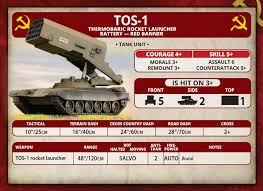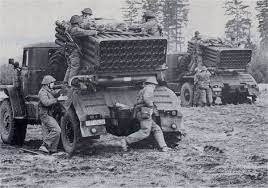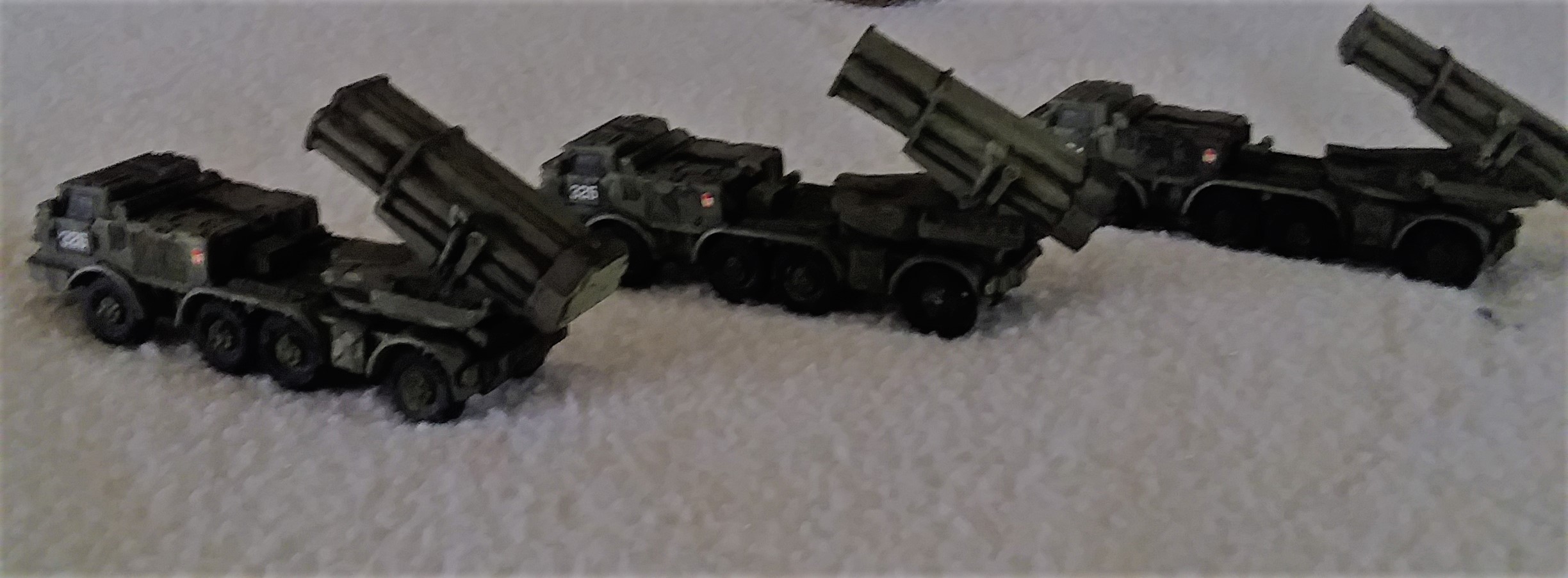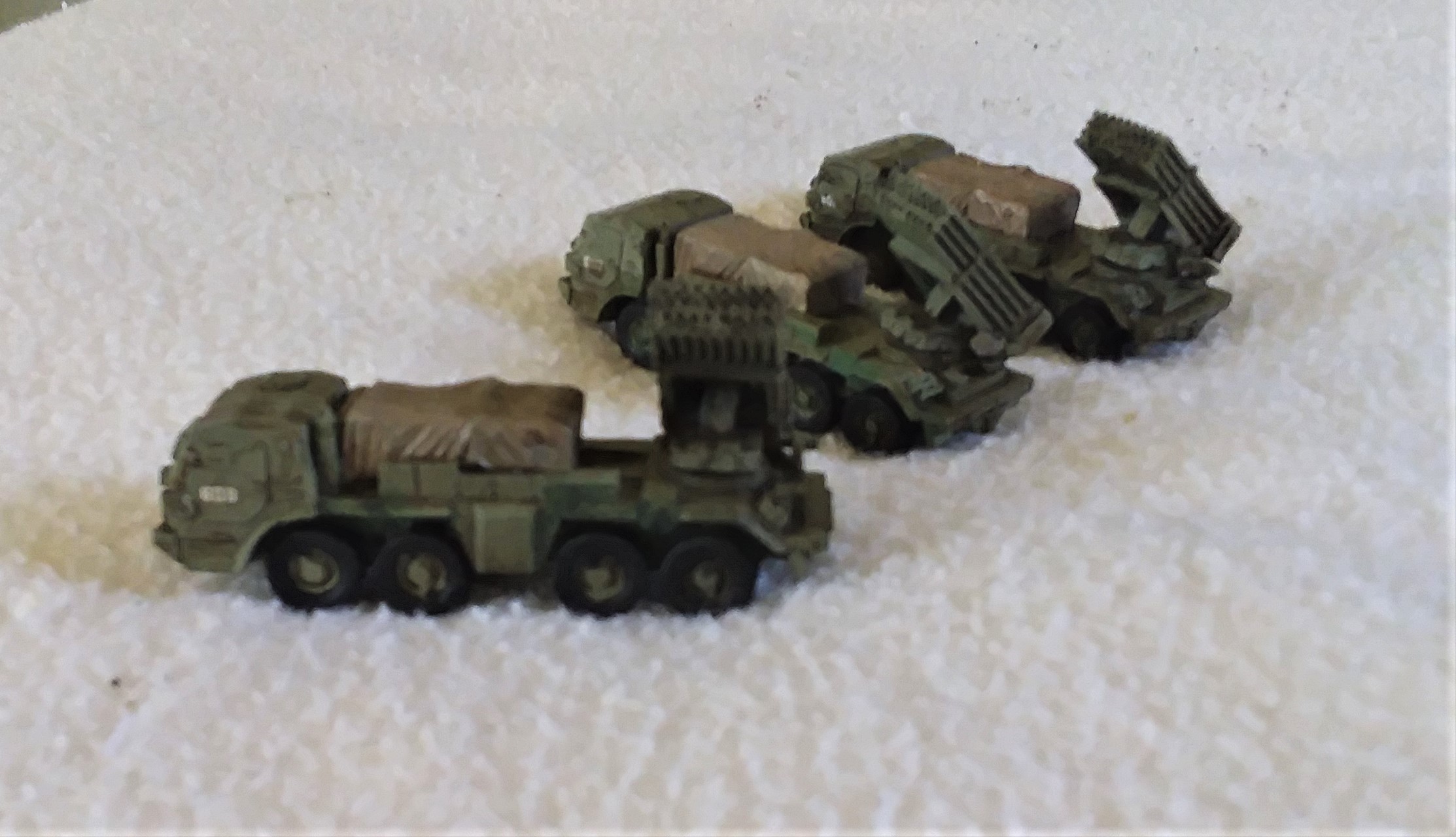TOS-UP
By Jim Naughton
Introduction
With the publication of World War III: Team Yankee Soviets https://www.flamesofwar.com/hobby.aspx?art_id=7154 the options for Soviet artillery nearly doubled. Battlefront added the BM-27 Hurricane and the TOS-1 Buratino. Opinions about the effectiveness of these new tools vary, and they have a significant AP differential over the older systems.
The recent publication of World War III: Team Yankee Warsaw Pact https://www.flamesofwar.com/hobby.aspx?art_id=7455 updates the PACT-unique artillery, providing options for the East Germans that didn’t exist at the publication of Volksarmee several years ago. Also, the issue of black box support for PACT armies is cleared up.
By blending allied forces the PACT player literally has a golf bag of options. A PACT player can choose to array his troops as Soviet allies, and access the newer Soviet artillery, or make his core a PACT force and use the better skill of PACT supporting artillery units.
Various social media forums continually pose questions about the optimal mix of PACT weapons. The correspondent’s opinions (including mine) vary considerably and are mostly supported by anecdotes. This article is intended to examine the issue with arcane lore called mathematics.
Before getting into the hard stuff, it’s worth examining the background.
Warsaw Pact Artillery Organization
Artillery was a powerful part of the PACT war machine, and Team Yankee only covers a portion. Every PACT motor infantry or air assault battalion had mortars, but the design criteria of Team Yankee eliminates this capability. Self-propelled Soviet mortars made their debut in the mid-80s so there is the possibility Battlefront might reconsider the issue, but today it’s a moot point.
At every level we find extensive artillery support. A battalion in every regiment, a regiment in every division, at least a brigade in every Army, and at least a division of artillery in every Front.
The PACT, unlike NATO, heavily task-organized artillery. The Chief of Fire Support in the Regiment obviously had direction for his 122mm regimental battalion, but first echelon regiments were often augmented with firing units from Division and second-echelon regiments within the same division. This is the source of the BM-21 and 2S3 weapons found in the PACT/Soviet force diagrams, as well as the extra 2S1 howitzers. NATO identified regimental artillery task force as the Regimental Artillery Group(ment). Or ‘RAG.’
When augmented from Army or Front, the division had the authority to pass the augmentation forward to its engaged regiments, and so these higher echelon assets could be found at the regimental level. This is the source of the TOS-1 (from an Army-level Chemical Defense battalion) and BM-27 (from Army or Front-level artillery formations). The residue of the Division artillery regiment, augmented by second echelon regiments’ artillery and assets attached forward from Army or Front, NATO called the Division Artillery Group(ment). ‘DAG.’
Now to discuss the weapons of Team Yankee.
Soviet Weapons
2S1 Carnation

The 2S1 Carnation is a 122mm 2A18 howitzer mounted on the MTLB chassis. First production was in 1971 with the Soviets producing roughly 10,000 in twenty years. The 2S1 initially replaced aging assault guns in tank regiments and towed 122mm guns in the motor rifle regiments of tank divisions. The organization was 18 tubes to the artillery battalion in BMP regiments and tank regiments. By 1985, some units were expanding to 24 tubes, and the Soviets were experimenting with them in BTR regiments.
The 2S1 in 1985 had a maximum range was 15 kilometers. The ammunition of the period included two types of HE, two types of HEAT, and WP Smoke. An optional flechette round was introduced in the early ‘80s. In the early ‘90s, the 3OF69M (Kitopol) laser-guided projectile was introduced, giving the 2S1 and related weapons a comparable capability to Krasnopol.
The ammunition mix reflects the 2A18 gun’s design for direct fire as well as bombardment – a facet of Soviet artillery doctrine with no counterpart in NATO. The RAG expected to shoot in assaults over open sights, or supplement ATGM and towed antitank in defense.
The 2S1’s design focused on mobility, and like the BMPs it supported, is fully amphibious.
2S3 Acacia

The 2S3 Acacia is a self-propelled 152mm D-22 howitzer (itself a modification of the D-20 first introduced in 1955). The chassis is shared with the SA-4 Ganef, but substantially modified. It began replacing towed 152mm divisional guns in mechanized formations in 1971, initially on a basis of a single battalion per divisional regiment. By 1985 Soviet forward-deployed units in PACT nations had received a second battalion and ten divisions in Germany had three battalions in their divisional artillery.
The 2S3 has a similar mix of projectiles to the 2S1, with the addition of Krasnopol Laser-guided projectiles. Also (but not recognized by Battlefront, maybe next book) the Soviets introduced DP-ICM projectiles in the late ‘80s. The HEAT rounds lack the penetration of the 2S1 despite being larger, but the after-armor effects are substantial.
Unlike 2S1, the weight of the vehicle and the chassis design precluded amphibious operations, and BF gives it a 4+ cross check. It did include an AA machine gun.
BM-21 Hail

Compared to the two self-propelled guns, the BM-21 is a venerable system. It entered service in 1963, replacing the short-ranged 140mm BM-14. The BM-21 122mm rockets spawned a whole family of warheads and transporter vehicles. The basic BM-21 was mounted on the Ural-375 6×6 truck, but this was changed to the Ural-4320 and eventually the Ural-43201 as the Ural trucks evolved. All these variants were equipped with the 40-tube launcher.
The system was also produced on the ZIL-131 creating a ‘GRAD-1’ variant with only 38 tubes. The standard BM-21 and the GRAD-1 were judged too heavy and fragile for airdrop without special preparation, so the BM-21V was produced for the VDV. This is a 12-tube launcher on a 4×4 GAZ-66 truck.
The Spetsnaz wanted to get into the act, and so the single-shot BM-21P was developed but not adopted. However, the system was sold to the People’s Army of Vietnam, among others, where it formed the basis of the Front-Jet-Artillery units depicted in ‘NAM.
The Red Banner Fleets also used the system, having a 20-shot launcher for shipboard use, and a BM-21PD 40-tube launcher used in coastal defense to attack submersibles and swimmers in shallow water.
Approaching 100,000 MRLs were built
The Soviets had many warhead variants. The basic warhead family included HE, Chemical, Chemical Smoke, Incendiary Smoke plus depth charges and ranged out to 20 kilometers. But by the ‘80s the Soviets had added DP-ICM and anti-tank mines to their repertoire. And increased range for the DP-ICM to 30 kilometers. The 9M521 and 9M522 rockets produced near the end of the Cold War (and continuing in production today) have up to 40 kilometers’ range.
The main weakness in the BM-21 is being mounted on a truck. Survivability under counterbattery fire and aircraft guns is low. Cross check is 4+ and it is not amphibious.
BM-27 Hurricane

The BM-27 entered service in 1976 and was assigned to the Rocket Artillery Regiments of the Army and Front, starting with a single battalion of 18. Its weapon is the 9M27 family of 240mm rockets. Approximately 1,500 were produced during the Soviet era, and production has continued. Like the BM-21, it replaced older heavy rocket systems with much shorter range, like the BM-24.
The basic BM-27 system consisted of 16 tubes mounted on a ZIL-135 8×8 truck. As appropriate for a moving van the cross check is 5+.
The 9M27 family, unlike the MLRS of the ‘80s, was a complete family of munitions. The 9M27F was the HE variant. The 27K2, 27K3 and 9M59 delivered a mix of antipersonnel, antivehicle, and antitank mines. The 27K1 delivered an antimaterial submunition suitable for wrecking lightly armored support vehicles, radars, and supply depots. The 27S was incendiary smoke (WP). The 9M27 rockets had 35-kilometer range, slightly outranging basic MLRS.
In 1989 the BM-27 was supplemented by small numbers of BM-30 300mm SMERCH. Mounted on a similar chassis this weapon added longer range (90 kilometer) 9K55 family of rockets/missiles to the Army and Front artillery. It also gave the Rocket Artillery brigades thermobaric capability. Maybe next book?
TOS-1 Buratino

The Tyazhelaya Ognemetnaay Sistema (heavy flamethrower system) designated TOS-1 was a developmental system in the 1980s. The nickname Buratino is a reference to a Russian children’s book character like Pinocchio.
The Soviet intent was to replace some of the aging OT-55 and OT-62 flame tanks found in the Army-level Flame Tank units. Early fighting in Afghanistan demonstrated the difficulty of moving the OT-55/62 over mountain tracks close enough to use flame weapons on mountain villages. Carrying the heavy infantry flamethrowers in mountainous Afghanistan was problematic.
Establishing a basis of issue for the system is difficult – the Soviets never admitted the system existed, and the Russians only ‘revealed’ the system in 1999. Estimating the number built is similarly cloudy.
The TOS-1 is twenty-four 220mm tubes mounted on a T72 hull, giving it some armor protection and excellent cross-country mobility – better than the OT-55/62. With a range of 3,500 meters, just a little over TOW missile range, it needed the protection. And like its lesser brethren of the Flame Tank organizations, it was attached well forward.
TOS-1 does not enable the Soviet BMP observer team because it was not part of an artillery organization. Its inability to produce smoke is a simplification – a sustained barrage of TOS rockets could be used to produce a flame front a kilometer wide with every volley. And setting villages afire or blasting apart minefields isn’t in the TY playbook. So TOS is a one-trick pony – very capable against infantry.
But remember, in the real world, only TOS can prevent forests.
To summarize the contestant’s statistics for the next part of this article, here are the numbers:
TABLE 1: SOVIET TY ARTILLERY

PACT UNIQUE ARTILLERY
The Czechoslovakians have a long history of producing armaments and a high reputation for quality. This stretched back to the early 20th Century when Skoda Works in Pilsen secretly produced the 305mm siege mortar that complemented the German Empire’s ‘Big Bertha’ throughout World War I. During the Cold War, they produced licensed versions of the T55 and T72 that were well-regarded. They continued their reputation for excellence in artillery systems by producing the 152mm DANA self-propelled howitzer and the RM-70 122MM multiple rocket launcher.
DANA 152mm Self-propelled Howitzer

The DANA (Dělo Automobilní Nabíjené Automaticky) marries an armored turret to a truck chassis, using the home-grown Tatra 815 vehicle to carry the weapon. The weapon features an autoloader, making it unique among PACT artillery of the period, and was designed so the autoloader feed system worked at all elevations of the tube. The carrier uniquely has been divided in half to accommodate the turret and allow autoloading in all elevation positions.
The Czechs provided the DANA with a 12.7mm AA machine gun.
The People’s Republic produced over 600 before splitting up, 408 for domestic service, 111 sold to Poland, and 108 sold to the Soviet Union. Production continued in Slovakia for foreign military sales well into the ‘90s. Maybe next book we will see Soviet DANA.
The system was surprisingly mobile for a wheeled weapon, with adjustable tire pressure to improve cross-country traction. BF gives it a 5+ cross with a big road dash (36”). The weapon had to tediously deploy stabilizer jacks and BF reflects that with a ‘-‘ ROF on the move.
RM-70 122mm Mobile Rocket Launcher

The Czechs skipped the BM-21, designing their own carrier with an armored cab. The RM-70 (Raketomet Vor 1970) was adopted for service in the People’s Army in 1972, replacing BM-14 MRLs and older systems. The chassis was the domestic Tatra T813 truck.
The system used the Soviet 122mm rockets found with BM-21, but the Czechs also had their own munitions – the JROF family which included a ‘heavy’ warhead with roughly double the lethality but just over half the range, DPICM, plus minelaying rockets. The Slovaks have continued to evolve their munitions, and today’s JROF-L claims 40-kilometer range.
As with BM-21, currently BF only recognizes the basic HE and smoke munitions.
The Czechs provided the RM-70 with a 7.62mm AA machine gun.
TABLE 2: PACT UNIQUE TY ARTILLERY

Next time: PART II Calculating Lethality and Comparing Weapons

Nice article, Jim. Now I know what those miscellaneous targets are!
It is less simple than the NATO offerings (M109, MLRS, Abbot, LARs, and AMX Auf1 (M109 with attitude).